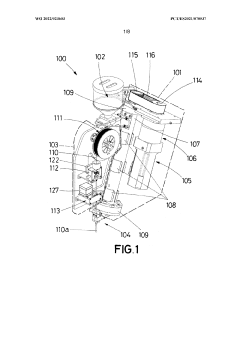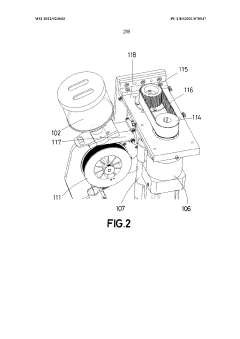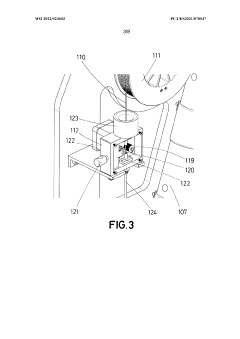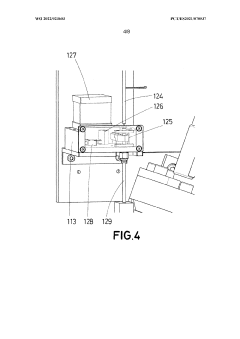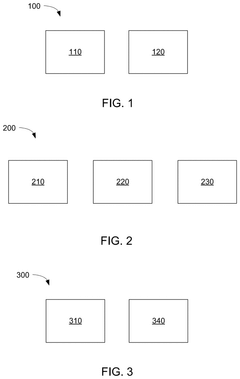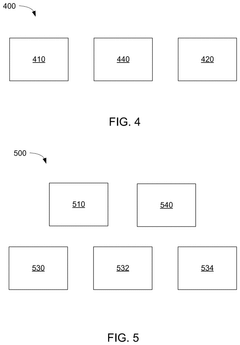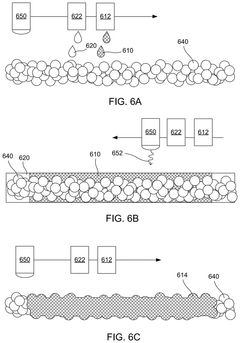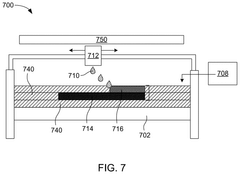Ferrofluid's Potential in Advancing 3D Printing Capabilities
JUL 9, 20259 MIN READ
Generate Your Research Report Instantly with AI Agent
Patsnap Eureka helps you evaluate technical feasibility & market potential.
Ferrofluid 3D Printing Background and Objectives
Ferrofluids, a unique class of magnetic nanomaterials, have recently emerged as a promising candidate for advancing 3D printing capabilities. These colloidal suspensions of magnetic nanoparticles in a carrier fluid exhibit remarkable properties that can potentially revolutionize additive manufacturing processes. The integration of ferrofluids into 3D printing technology represents a convergence of materials science, nanotechnology, and advanced manufacturing techniques.
The development of ferrofluids dates back to the 1960s when NASA scientists sought to create a magnetic liquid for controlling fluids in space. Since then, ferrofluids have found applications in various fields, including electronics, mechanical engineering, and biomedical sciences. However, their potential in 3D printing has only recently begun to be explored, marking a new frontier in materials science and manufacturing innovation.
The primary objective of incorporating ferrofluids into 3D printing is to enhance the precision, functionality, and versatility of printed objects. By leveraging the unique magnetic properties of ferrofluids, researchers aim to achieve greater control over the printing process, enabling the creation of complex structures with tunable properties. This integration could potentially lead to the development of smart materials and adaptive structures that respond to external magnetic fields.
One of the key technological trends driving this research is the growing demand for multifunctional and responsive materials in various industries. As traditional manufacturing methods reach their limits in terms of complexity and customization, 3D printing with ferrofluids offers a promising avenue for creating materials with programmable properties and behaviors.
The evolution of 3D printing technology itself has paved the way for the incorporation of novel materials like ferrofluids. Advancements in print head design, material extrusion techniques, and multi-material printing capabilities have created a fertile ground for experimenting with magnetic nanomaterials in additive manufacturing processes.
Researchers are particularly interested in exploring how ferrofluids can be used to create structures with anisotropic properties, self-healing capabilities, and dynamic responsiveness to external stimuli. These features could have far-reaching implications in fields such as soft robotics, biomedical implants, and smart sensors.
As we delve deeper into the potential of ferrofluids in 3D printing, it is crucial to consider the challenges that lie ahead. These include optimizing the rheological properties of ferrofluid-based printing materials, developing precise control mechanisms for magnetic field application during printing, and ensuring the long-term stability of printed structures. Overcoming these hurdles will be essential in realizing the full potential of this innovative approach to additive manufacturing.
The development of ferrofluids dates back to the 1960s when NASA scientists sought to create a magnetic liquid for controlling fluids in space. Since then, ferrofluids have found applications in various fields, including electronics, mechanical engineering, and biomedical sciences. However, their potential in 3D printing has only recently begun to be explored, marking a new frontier in materials science and manufacturing innovation.
The primary objective of incorporating ferrofluids into 3D printing is to enhance the precision, functionality, and versatility of printed objects. By leveraging the unique magnetic properties of ferrofluids, researchers aim to achieve greater control over the printing process, enabling the creation of complex structures with tunable properties. This integration could potentially lead to the development of smart materials and adaptive structures that respond to external magnetic fields.
One of the key technological trends driving this research is the growing demand for multifunctional and responsive materials in various industries. As traditional manufacturing methods reach their limits in terms of complexity and customization, 3D printing with ferrofluids offers a promising avenue for creating materials with programmable properties and behaviors.
The evolution of 3D printing technology itself has paved the way for the incorporation of novel materials like ferrofluids. Advancements in print head design, material extrusion techniques, and multi-material printing capabilities have created a fertile ground for experimenting with magnetic nanomaterials in additive manufacturing processes.
Researchers are particularly interested in exploring how ferrofluids can be used to create structures with anisotropic properties, self-healing capabilities, and dynamic responsiveness to external stimuli. These features could have far-reaching implications in fields such as soft robotics, biomedical implants, and smart sensors.
As we delve deeper into the potential of ferrofluids in 3D printing, it is crucial to consider the challenges that lie ahead. These include optimizing the rheological properties of ferrofluid-based printing materials, developing precise control mechanisms for magnetic field application during printing, and ensuring the long-term stability of printed structures. Overcoming these hurdles will be essential in realizing the full potential of this innovative approach to additive manufacturing.
Market Analysis for Ferrofluid-Enhanced 3D Printing
The market for ferrofluid-enhanced 3D printing is poised for significant growth as the technology matures and finds applications across various industries. The global 3D printing market, valued at $13.7 billion in 2021, is expected to expand at a compound annual growth rate (CAGR) of 20.8% from 2022 to 2030. Within this broader market, ferrofluid-enhanced 3D printing represents a niche but rapidly growing segment.
The integration of ferrofluids in 3D printing processes offers several advantages that are driving market demand. These include improved print resolution, enhanced material properties, and the ability to create complex magnetic structures. Industries such as aerospace, automotive, healthcare, and consumer electronics are showing particular interest in this technology.
In the aerospace sector, ferrofluid-enhanced 3D printing is being explored for the production of lightweight, high-strength components with embedded magnetic properties. This could lead to the development of more efficient and durable aircraft parts. The automotive industry is investigating the use of this technology for creating advanced sensors and actuators, potentially revolutionizing vehicle performance and safety systems.
The healthcare sector presents a significant opportunity for ferrofluid-enhanced 3D printing. The technology's ability to create precise, customized magnetic structures is particularly valuable in the development of medical devices, implants, and drug delivery systems. As personalized medicine continues to gain traction, the demand for such tailored solutions is expected to grow substantially.
Consumer electronics manufacturers are also showing interest in ferrofluid-enhanced 3D printing for creating novel haptic feedback systems and miniaturized components. This could lead to more immersive user experiences in devices such as smartphones, wearables, and virtual reality headsets.
Despite the promising outlook, the market for ferrofluid-enhanced 3D printing faces some challenges. The high cost of materials and equipment, coupled with the need for specialized expertise, currently limits widespread adoption. Additionally, regulatory hurdles, particularly in healthcare applications, may slow market growth in certain sectors.
However, ongoing research and development efforts are addressing these challenges. Advancements in material science are expected to reduce costs and improve the performance of ferrofluid-enhanced 3D printed products. As the technology becomes more accessible and its benefits become more widely recognized, market penetration is likely to accelerate.
In conclusion, the market for ferrofluid-enhanced 3D printing shows strong growth potential, driven by its unique capabilities and diverse applications across multiple industries. As technical barriers are overcome and costs decrease, this innovative technology is poised to capture an increasing share of the rapidly expanding 3D printing market.
The integration of ferrofluids in 3D printing processes offers several advantages that are driving market demand. These include improved print resolution, enhanced material properties, and the ability to create complex magnetic structures. Industries such as aerospace, automotive, healthcare, and consumer electronics are showing particular interest in this technology.
In the aerospace sector, ferrofluid-enhanced 3D printing is being explored for the production of lightweight, high-strength components with embedded magnetic properties. This could lead to the development of more efficient and durable aircraft parts. The automotive industry is investigating the use of this technology for creating advanced sensors and actuators, potentially revolutionizing vehicle performance and safety systems.
The healthcare sector presents a significant opportunity for ferrofluid-enhanced 3D printing. The technology's ability to create precise, customized magnetic structures is particularly valuable in the development of medical devices, implants, and drug delivery systems. As personalized medicine continues to gain traction, the demand for such tailored solutions is expected to grow substantially.
Consumer electronics manufacturers are also showing interest in ferrofluid-enhanced 3D printing for creating novel haptic feedback systems and miniaturized components. This could lead to more immersive user experiences in devices such as smartphones, wearables, and virtual reality headsets.
Despite the promising outlook, the market for ferrofluid-enhanced 3D printing faces some challenges. The high cost of materials and equipment, coupled with the need for specialized expertise, currently limits widespread adoption. Additionally, regulatory hurdles, particularly in healthcare applications, may slow market growth in certain sectors.
However, ongoing research and development efforts are addressing these challenges. Advancements in material science are expected to reduce costs and improve the performance of ferrofluid-enhanced 3D printed products. As the technology becomes more accessible and its benefits become more widely recognized, market penetration is likely to accelerate.
In conclusion, the market for ferrofluid-enhanced 3D printing shows strong growth potential, driven by its unique capabilities and diverse applications across multiple industries. As technical barriers are overcome and costs decrease, this innovative technology is poised to capture an increasing share of the rapidly expanding 3D printing market.
Current Challenges in Ferrofluid 3D Printing Technology
The integration of ferrofluids into 3D printing technology presents several significant challenges that currently limit its widespread adoption and full potential realization. One of the primary obstacles is the precise control of ferrofluid behavior during the printing process. Ferrofluids are known for their unique responsiveness to magnetic fields, which can lead to unpredictable movements and shape changes when subjected to external magnetic forces. This inherent instability makes it difficult to maintain consistent print quality and achieve high-resolution structures.
Another major challenge lies in the development of suitable printing materials that can effectively incorporate ferrofluids while maintaining the desired mechanical and functional properties of the final printed object. The inclusion of ferrofluid particles can significantly alter the rheological properties of the printing medium, affecting its flow characteristics and solidification behavior. This necessitates careful formulation and optimization of the printing materials to ensure compatibility with existing 3D printing technologies.
The long-term stability of ferrofluid-infused 3D printed objects is also a concern. Over time, there is a risk of ferrofluid particle aggregation or separation from the matrix material, which could lead to degradation of the object's magnetic properties and overall structural integrity. Addressing this issue requires the development of advanced encapsulation techniques or the creation of novel composite materials that can maintain the ferrofluid's dispersion and functionality over extended periods.
Furthermore, the current limitations in magnetic field control systems pose a significant hurdle. To fully exploit the potential of ferrofluids in 3D printing, precise and dynamic manipulation of magnetic fields during the printing process is essential. However, existing magnetic field generation and control technologies may not offer the level of spatial and temporal resolution required for complex, multi-material ferrofluid-based 3D printing applications.
The lack of standardized characterization methods and quality control protocols for ferrofluid-enhanced 3D printed objects also presents a challenge. Without established standards, it becomes difficult to assess and compare the performance of different ferrofluid formulations and printing techniques across various applications. This hampers the development of reliable and reproducible manufacturing processes for ferrofluid-based 3D printed products.
Lastly, the integration of ferrofluids into existing 3D printing workflows and software platforms remains a significant challenge. Current slicing software and printer control systems are not optimized for handling the unique properties and behaviors of ferrofluids, necessitating the development of specialized algorithms and printing parameters to achieve desired outcomes. Overcoming these challenges will be crucial for unlocking the full potential of ferrofluids in advancing 3D printing capabilities and enabling novel applications across various industries.
Another major challenge lies in the development of suitable printing materials that can effectively incorporate ferrofluids while maintaining the desired mechanical and functional properties of the final printed object. The inclusion of ferrofluid particles can significantly alter the rheological properties of the printing medium, affecting its flow characteristics and solidification behavior. This necessitates careful formulation and optimization of the printing materials to ensure compatibility with existing 3D printing technologies.
The long-term stability of ferrofluid-infused 3D printed objects is also a concern. Over time, there is a risk of ferrofluid particle aggregation or separation from the matrix material, which could lead to degradation of the object's magnetic properties and overall structural integrity. Addressing this issue requires the development of advanced encapsulation techniques or the creation of novel composite materials that can maintain the ferrofluid's dispersion and functionality over extended periods.
Furthermore, the current limitations in magnetic field control systems pose a significant hurdle. To fully exploit the potential of ferrofluids in 3D printing, precise and dynamic manipulation of magnetic fields during the printing process is essential. However, existing magnetic field generation and control technologies may not offer the level of spatial and temporal resolution required for complex, multi-material ferrofluid-based 3D printing applications.
The lack of standardized characterization methods and quality control protocols for ferrofluid-enhanced 3D printed objects also presents a challenge. Without established standards, it becomes difficult to assess and compare the performance of different ferrofluid formulations and printing techniques across various applications. This hampers the development of reliable and reproducible manufacturing processes for ferrofluid-based 3D printed products.
Lastly, the integration of ferrofluids into existing 3D printing workflows and software platforms remains a significant challenge. Current slicing software and printer control systems are not optimized for handling the unique properties and behaviors of ferrofluids, necessitating the development of specialized algorithms and printing parameters to achieve desired outcomes. Overcoming these challenges will be crucial for unlocking the full potential of ferrofluids in advancing 3D printing capabilities and enabling novel applications across various industries.
Existing Ferrofluid 3D Printing Solutions
01 Ferrofluid-based 3D printing materials
Ferrofluids can be incorporated into 3D printing materials to create magnetically responsive structures. These materials combine magnetic nanoparticles with printable polymers or resins, allowing for the fabrication of objects that can be manipulated or actuated using external magnetic fields. This technology enables the production of smart materials and structures with unique properties and functionalities.- Ferrofluid-based 3D printing materials: Ferrofluids can be incorporated into 3D printing materials to create unique magnetic properties in printed objects. These materials combine magnetic nanoparticles with traditional 3D printing resins or filaments, allowing for the production of parts that can respond to magnetic fields or have tunable magnetic characteristics.
- Magnetic field-assisted 3D printing techniques: 3D printing processes can be enhanced by applying magnetic fields during or after printing when using ferrofluid-based materials. This technique allows for precise control over the orientation and distribution of magnetic particles within the printed structure, enabling the creation of complex magnetic patterns or functionalities.
- Multi-material printing with ferrofluids: Advanced 3D printing systems can combine ferrofluids with other materials to create multi-functional objects. This capability allows for the integration of magnetic properties with other material characteristics, such as conductivity or flexibility, in a single printed part.
- Post-processing of ferrofluid-printed objects: After 3D printing with ferrofluid-based materials, various post-processing techniques can be applied to enhance or modify the magnetic properties of the printed objects. These may include heat treatment, magnetic field exposure, or surface treatments to optimize the final magnetic characteristics of the printed parts.
- Applications of ferrofluid 3D printed objects: Ferrofluid 3D printing enables the creation of novel devices and structures with unique magnetic functionalities. Potential applications include sensors, actuators, soft robotics, and biomedical devices that can be remotely controlled or manipulated using external magnetic fields.
02 Magnetic field-assisted 3D printing techniques
Advanced 3D printing techniques utilize magnetic fields to control the deposition and alignment of ferrofluid-containing materials during the printing process. These methods allow for precise manipulation of the material's orientation and distribution, enabling the creation of complex structures with anisotropic properties. Magnetic field-assisted printing can enhance the resolution and functionality of printed objects.Expand Specific Solutions03 Applications in soft robotics and actuators
Ferrofluid 3D printing capabilities are particularly valuable in the development of soft robotics and actuators. By incorporating ferrofluids into flexible structures, researchers can create shape-morphing devices that respond to magnetic stimuli. This technology enables the fabrication of soft robots with controllable movements and adaptive behaviors, suitable for various applications in biomedicine and engineering.Expand Specific Solutions04 Multi-material printing with ferrofluids
Advanced 3D printing systems allow for the simultaneous deposition of ferrofluids alongside other materials, enabling the creation of multi-functional composites. This capability facilitates the integration of magnetic properties with other material characteristics, such as conductivity or biocompatibility. Multi-material printing with ferrofluids opens up possibilities for creating complex devices with spatially varying properties.Expand Specific Solutions05 Post-processing and functionalization of ferrofluid-printed structures
Various post-processing techniques can be applied to enhance the properties and functionality of 3D-printed ferrofluid structures. These methods may include thermal treatments, surface modifications, or additional material deposition to improve magnetic responsiveness, durability, or other desired characteristics. Post-processing allows for further customization and optimization of the printed objects for specific applications.Expand Specific Solutions
Key Players in Ferrofluid and 3D Printing Industries
The ferrofluid technology in 3D printing is in its early developmental stages, with a growing market potential as the 3D printing industry expands. The global 3D printing market is projected to reach $63.46 billion by 2028, indicating significant growth opportunities for ferrofluid applications. While the technology is still emerging, several companies and research institutions are actively exploring its potential. Firms like Peridot Print LLC and Chromatic 3D Materials, Inc. are at the forefront of developing innovative 3D printing materials, potentially including ferrofluids. Academic institutions such as Huazhong University of Science & Technology and Tongji University are conducting research to advance this technology, suggesting a collaborative ecosystem between industry and academia in driving ferrofluid innovation in 3D printing.
Huazhong University of Science & Technology
Technical Solution: Researchers at Huazhong University have developed a novel 3D printing technique using ferrofluids for creating complex magnetic structures. Their method involves using a magnetic field to control the orientation and distribution of magnetic particles within a photopolymer resin. By precisely manipulating the magnetic field during the printing process, they can create intricate 3D structures with programmed magnetic properties. This technique has been successfully applied to create soft actuators, sensors, and even miniature robots with embedded magnetic functionalities[6]. The university has also explored the use of ferrofluids in creating adaptive optical devices, such as tunable lenses and mirrors, which can be dynamically controlled using external magnetic fields[7].
Strengths: Ability to create complex magnetic structures, potential for smart materials and devices. Weaknesses: May be limited to specific materials compatible with magnetic manipulation.
Nexa3D, Inc.
Technical Solution: Nexa3D has been investigating the use of ferrofluids to enhance their ultra-fast 3D printing technology. Their approach involves incorporating ferrofluids into their proprietary photopolymer resins to improve print speed and resolution. By applying magnetic fields during the printing process, Nexa3D can achieve better control over resin flow and curing, resulting in faster print times and improved surface finish. The company has reported print speeds up to 1 cm per minute in the Z-axis, significantly faster than traditional SLA or DLP printers[8]. Additionally, Nexa3D is exploring the use of ferrofluids to create functionally graded materials, allowing for seamless transitions between different material properties within a single print[9].
Strengths: Ultra-fast printing speeds, potential for improved resolution and surface finish. Weaknesses: May be limited to specific resin formulations, potentially higher cost compared to traditional 3D printing materials.
Core Innovations in Ferrofluid 3D Printing
Print head for additive plastic manufacturing and methods
PatentWO2022023603A1
Innovation
- A print head and 3D printer system that uses solid thermoplastic pellets to produce a thermoplastic fluid, which is then coated onto continuous filaments with reinforcing fibers, enhancing the mechanical and structural properties of the deposited material, allowing for the creation of large, rigid, and complex geometries with improved mechanical resistance.
Three-dimensional printing with metal oxide nanoparticle fusing agents
PatentPendingUS20250026944A1
Innovation
- The use of multi-fluid kits and systems for three-dimensional printing that incorporate a fusing agent containing metal oxide nanoparticles, such as titanium dioxide, zinc oxide, or cerium oxide, which selectively absorb UV radiation to fuse polymer particles, allowing for the creation of clear or colored 3D printed articles with improved mechanical properties.
Material Safety and Environmental Considerations
The integration of ferrofluids in 3D printing processes necessitates a thorough examination of material safety and environmental considerations. Ferrofluids, composed of nanoscale ferromagnetic particles suspended in a carrier fluid, present unique challenges in terms of handling, disposal, and potential environmental impact.
From a safety perspective, the primary concern lies in the potential inhalation or dermal exposure to nanoparticles during the printing process. While the carrier fluid typically encapsulates the magnetic particles, the high-temperature conditions in some 3D printing techniques may lead to particle aerosolization. This risk necessitates the implementation of robust ventilation systems and personal protective equipment for operators working with ferrofluid-based 3D printing materials.
The environmental implications of ferrofluid use in 3D printing extend beyond the immediate workspace. The disposal of waste materials and unused ferrofluids requires careful consideration to prevent contamination of soil and water systems. The nanoscale particles in ferrofluids have the potential to persist in the environment and may interact with biological systems in ways that are not yet fully understood. Consequently, proper containment and disposal protocols must be established to mitigate these risks.
Recycling and reuse of ferrofluids present both opportunities and challenges. While the magnetic properties of these materials could theoretically facilitate their recovery from waste streams, the complex composition of 3D printed objects may complicate separation processes. Developing efficient recycling methods for ferrofluid-containing prints could significantly reduce the environmental footprint of this technology.
The long-term stability of ferrofluid-printed objects also warrants investigation. As these materials age, there is potential for the release of nanoparticles into the environment through wear or degradation. This raises questions about the lifecycle management of products created using ferrofluid-enhanced 3D printing techniques.
Regulatory frameworks governing the use of nanomaterials in manufacturing processes will need to evolve to address the specific challenges posed by ferrofluids in 3D printing. This may include the development of new testing protocols to assess the potential for nanoparticle release during product use and disposal.
Research into biocompatible ferrofluids could open new avenues for safer and more environmentally friendly applications, particularly in medical and consumer product domains. However, such developments must be accompanied by rigorous toxicological studies to ensure the long-term safety of these materials.
From a safety perspective, the primary concern lies in the potential inhalation or dermal exposure to nanoparticles during the printing process. While the carrier fluid typically encapsulates the magnetic particles, the high-temperature conditions in some 3D printing techniques may lead to particle aerosolization. This risk necessitates the implementation of robust ventilation systems and personal protective equipment for operators working with ferrofluid-based 3D printing materials.
The environmental implications of ferrofluid use in 3D printing extend beyond the immediate workspace. The disposal of waste materials and unused ferrofluids requires careful consideration to prevent contamination of soil and water systems. The nanoscale particles in ferrofluids have the potential to persist in the environment and may interact with biological systems in ways that are not yet fully understood. Consequently, proper containment and disposal protocols must be established to mitigate these risks.
Recycling and reuse of ferrofluids present both opportunities and challenges. While the magnetic properties of these materials could theoretically facilitate their recovery from waste streams, the complex composition of 3D printed objects may complicate separation processes. Developing efficient recycling methods for ferrofluid-containing prints could significantly reduce the environmental footprint of this technology.
The long-term stability of ferrofluid-printed objects also warrants investigation. As these materials age, there is potential for the release of nanoparticles into the environment through wear or degradation. This raises questions about the lifecycle management of products created using ferrofluid-enhanced 3D printing techniques.
Regulatory frameworks governing the use of nanomaterials in manufacturing processes will need to evolve to address the specific challenges posed by ferrofluids in 3D printing. This may include the development of new testing protocols to assess the potential for nanoparticle release during product use and disposal.
Research into biocompatible ferrofluids could open new avenues for safer and more environmentally friendly applications, particularly in medical and consumer product domains. However, such developments must be accompanied by rigorous toxicological studies to ensure the long-term safety of these materials.
Intellectual Property Landscape
The intellectual property landscape surrounding ferrofluid technology in 3D printing is rapidly evolving, reflecting the growing interest and potential applications in this field. A comprehensive analysis of patent filings and granted patents reveals several key trends and players shaping the future of ferrofluid-enhanced 3D printing.
Major technology companies and research institutions have been actively filing patents related to ferrofluid applications in 3D printing. These patents cover a wide range of innovations, including novel printing techniques, material compositions, and device designs. The patent landscape is particularly dense in areas such as magnetic field-assisted printing processes, ferrofluid-based support structures, and multi-material printing systems incorporating ferrofluids.
One significant trend observed in recent patent filings is the development of ferrofluid-based inks with enhanced properties. These innovations focus on improving the stability, printability, and functional characteristics of ferrofluid materials for 3D printing applications. Patents in this area often describe methods for optimizing particle size distribution, surfactant formulations, and carrier fluid compositions to achieve desired rheological and magnetic properties.
Another prominent area of patent activity relates to the integration of ferrofluids in post-processing techniques for 3D printed objects. These patents explore methods for using ferrofluids to enhance surface finishing, create dynamic textures, or enable responsive features in printed structures. Such innovations demonstrate the potential of ferrofluids to expand the capabilities of 3D printing beyond traditional static objects.
The geographical distribution of patent filings indicates a global interest in ferrofluid-enhanced 3D printing, with significant activity observed in the United States, China, Japan, and several European countries. This diverse patent landscape suggests a competitive and collaborative environment, with both established companies and emerging startups contributing to the field's advancement.
An analysis of patent citations and licensing agreements reveals the formation of strategic partnerships and technology transfer activities within the industry. These collaborations are crucial for overcoming technical challenges and accelerating the commercialization of ferrofluid-based 3D printing technologies.
As the field continues to mature, it is expected that the intellectual property landscape will become increasingly complex. Future patent activities are likely to focus on addressing current limitations, such as scalability issues and material compatibility, as well as exploring novel applications in sectors like biomedical engineering, soft robotics, and smart materials.
Major technology companies and research institutions have been actively filing patents related to ferrofluid applications in 3D printing. These patents cover a wide range of innovations, including novel printing techniques, material compositions, and device designs. The patent landscape is particularly dense in areas such as magnetic field-assisted printing processes, ferrofluid-based support structures, and multi-material printing systems incorporating ferrofluids.
One significant trend observed in recent patent filings is the development of ferrofluid-based inks with enhanced properties. These innovations focus on improving the stability, printability, and functional characteristics of ferrofluid materials for 3D printing applications. Patents in this area often describe methods for optimizing particle size distribution, surfactant formulations, and carrier fluid compositions to achieve desired rheological and magnetic properties.
Another prominent area of patent activity relates to the integration of ferrofluids in post-processing techniques for 3D printed objects. These patents explore methods for using ferrofluids to enhance surface finishing, create dynamic textures, or enable responsive features in printed structures. Such innovations demonstrate the potential of ferrofluids to expand the capabilities of 3D printing beyond traditional static objects.
The geographical distribution of patent filings indicates a global interest in ferrofluid-enhanced 3D printing, with significant activity observed in the United States, China, Japan, and several European countries. This diverse patent landscape suggests a competitive and collaborative environment, with both established companies and emerging startups contributing to the field's advancement.
An analysis of patent citations and licensing agreements reveals the formation of strategic partnerships and technology transfer activities within the industry. These collaborations are crucial for overcoming technical challenges and accelerating the commercialization of ferrofluid-based 3D printing technologies.
As the field continues to mature, it is expected that the intellectual property landscape will become increasingly complex. Future patent activities are likely to focus on addressing current limitations, such as scalability issues and material compatibility, as well as exploring novel applications in sectors like biomedical engineering, soft robotics, and smart materials.
Unlock deeper insights with Patsnap Eureka Quick Research — get a full tech report to explore trends and direct your research. Try now!
Generate Your Research Report Instantly with AI Agent
Supercharge your innovation with Patsnap Eureka AI Agent Platform!
